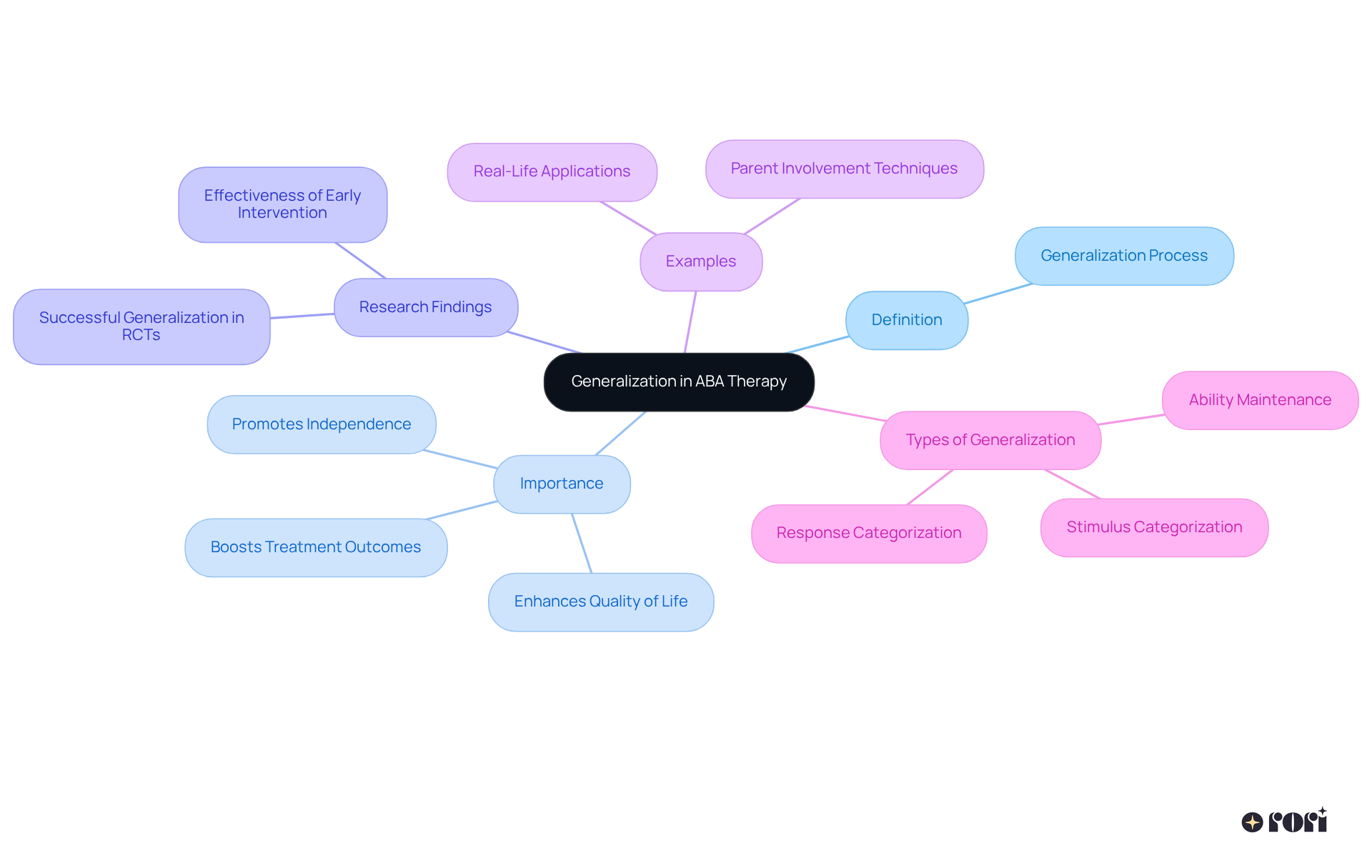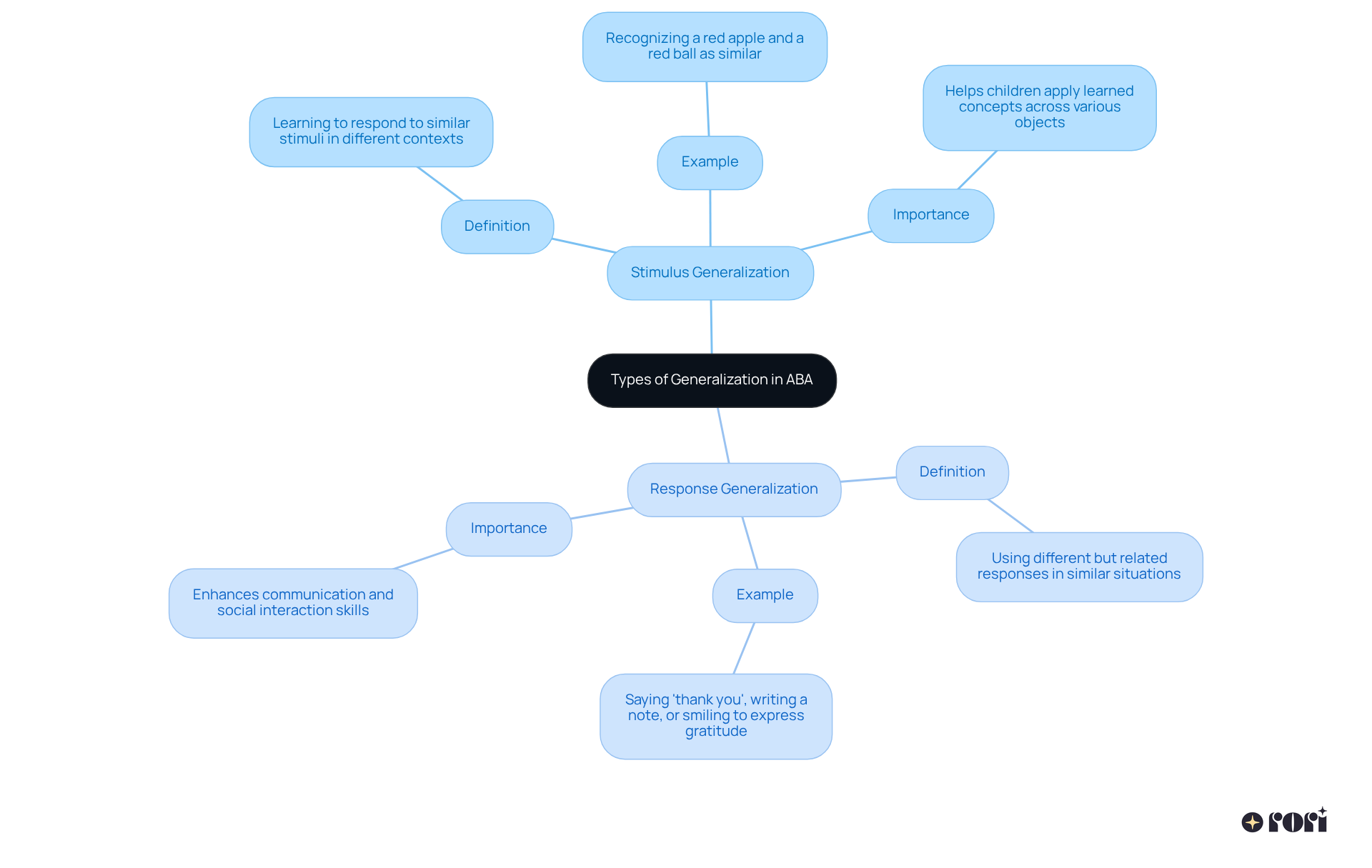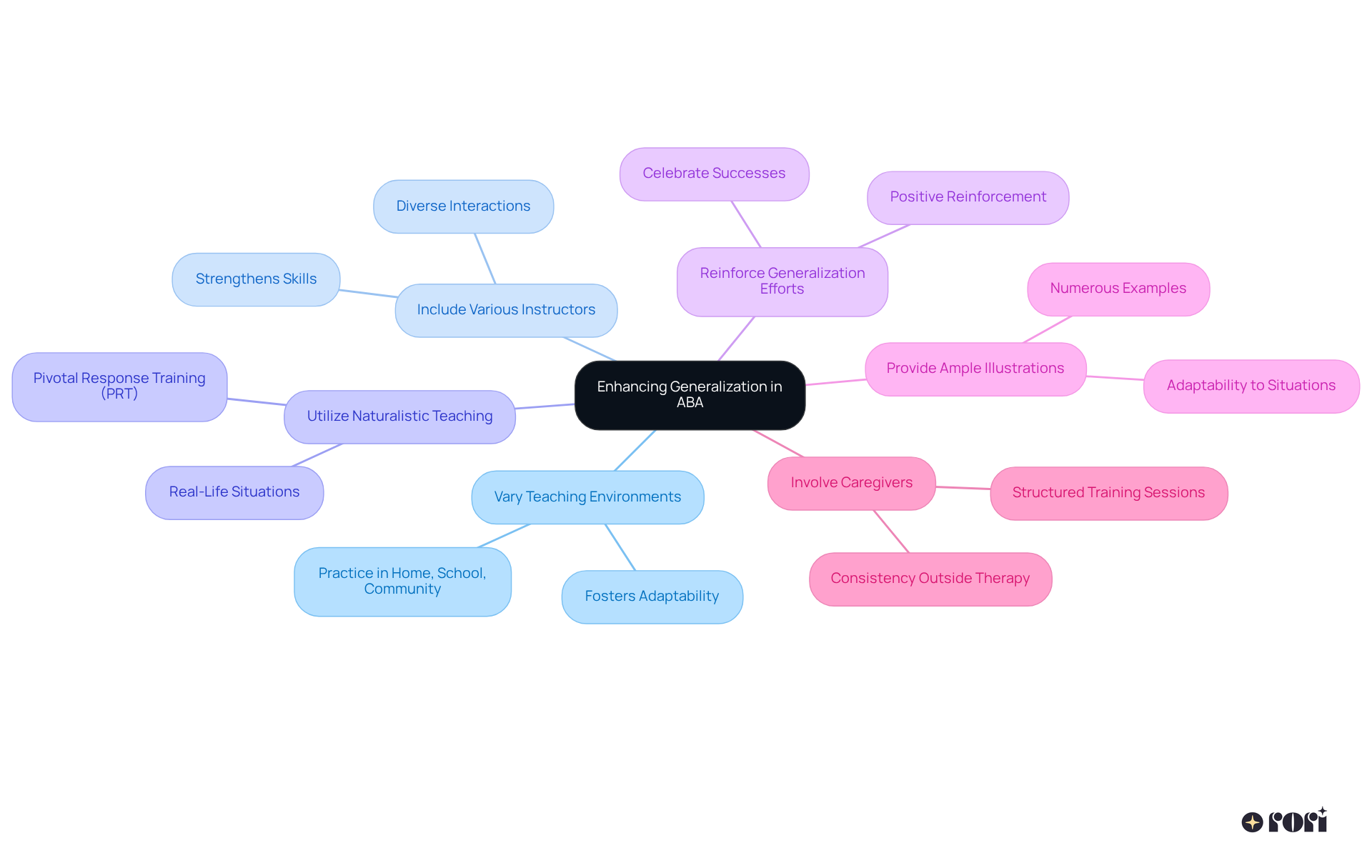In the world of Applied Behavior Analysis (ABA), generalization is all about helping individuals, especially children with autism, take the skills they've learned and use them in different places without needing direct guidance. This ability is so important! It can really boost their independence and enhance their overall quality of life. The article highlights how successful generalization can lead to better social interactions and adaptability. Plus, research backs this up, showing that when kids apply their skills outside of therapy sessions, the outcomes are often much better.
Let’s explore this together! Imagine a child who learns how to greet someone in therapy. If they can use that same skill at school or in a park, it opens up so many more opportunities for friendships and fun experiences. It’s all about making those connections in real-life situations, and that’s what we’re aiming for. We’re here to help you every step of the way in this journey!
Understanding the nuances of generalization in Applied Behavior Analysis (ABA) is essential for ensuring that skills learned in therapy extend into everyday life. This concept not only enhances treatment outcomes but also fosters independence among individuals, particularly children with autism.
But how can therapists effectively bridge the gap between structured learning environments and real-world applications? 🤔 Exploring the definition, importance, and various types of generalization reveals strategies that empower young learners to navigate diverse social situations with confidence and adaptability. Let’s explore this together!
The generalization definition aba in Applied Behavior Analysis (ABA) intervention emphasizes the importance of helping young people transfer the skills they learn in one setting to different situations without needing direct instruction. For example, when a child learns to say 'hello' to their therapist, it's a wonderful sign when they also greet their friends or family in similar situations. This process is crucial because it aligns with the generalization definition aba, ensuring that the skills gained during therapy extend beyond the therapy room, allowing children with autism to use what they've learned in their everyday lives.
Research shows that the generalization definition aba can significantly boost treatment outcomes and promote independence. It empowers individuals to navigate various social situations with confidence. In fact, studies indicate that early intervention in ABA treatment leads to better results, with children demonstrating improved skills across different settings. For instance, children at Chicago ABA Therapy achieved nearly all their goals during a two-year period before starting kindergarten.
By encouraging broad application, ABA therapy, as defined by the generalization definition aba, helps children adapt their skills to real-life situations, ultimately enhancing their quality of life. It's also helpful to understand that categorization can be divided into three main types:
Plus, the involvement of parents and caregivers is vital in supporting the transfer of learned skills into daily activities. Let’s explore this together and see how we can make a difference!

The generalization definition aba is a crucial aspect of Applied Behavior Analysis (ABA) treatment! It helps ensure that the skills learned during sessions can be used in real-life situations. Without these broader concepts, young individuals might only demonstrate what they've learned in structured settings, which can make it tough for them to act independently in different environments, highlighting the generalization definition aba. For instance, imagine a young person who learns to ask for help in therapy; they also need to be able to use this skill at school or home.
By encouraging a broader understanding of the generalization definition aba, therapists help kids manage social interactions, improve communication skills, and ultimately boost their overall quality of life. Studies have shown that when kids can transfer their skills successfully, it can significantly enhance their independence. This means they can engage more fully in community activities and develop essential life skills. Plus, research indicates that involving family members in the learning process can reinforce these behaviors outside of treatment, making it even easier for kids to apply what they've learned.
As young individuals become more adept at using their skills in various settings, their confidence grows! This leads to better adaptive functioning and a stronger sense of independence. So, let’s explore this together! We’re here to help you every step of the way!

In Applied Behavior Analysis (ABA) therapy, the generalization definition aba categorizes generalization into two main types: stimulus generalization and response generalization.
Stimulus Generalization happens when a young individual learns to respond to a specific stimulus in one context and applies that response to similar stimuli in different situations. For example, if a young learner identifies a red apple, they might also recognize a red ball as part of the same category. This shows their ability to generalize the concept of 'red' across different objects, which is pretty cool!
Response Generalization is all about a young person's ability to use different but related responses in similar situations. Imagine a child who learns to say 'thank you' when receiving help; they might also express gratitude in various ways, like writing a thank-you note or simply giving a smile. This flexibility in responding is so important for effective communication and social interaction.
Understanding these forms of generalization, specifically the generalization definition aba, is key to creating effective ABA strategies that help young individuals transfer their skills to different environments. By encouraging generalization, therapists can support kids in applying what they've learned in real-life scenarios, boosting their independence and adaptability. As Rori Behavioral Innovations Inc. states, the generalization definition aba serves as a cornerstone of Applied Behavior Analysis (ABA) intervention, particularly for individuals with autism, as it entails the capacity to transfer acquired abilities across different environments and contexts.
Furthermore, training in various settings and collaborating with caregivers and teachers are essential for strengthening these skills, ensuring that children can confidently navigate different environments. Let’s explore this together and see how we can help our little ones thrive!

To enhance generalization in ABA therapy, there are several effective strategies we can explore together:
Vary Teaching Environments: Practicing skills in different settings—like home, school, and community—helps kids apply what they've learned in various contexts. This fosters adaptability and makes learning feel more relevant.
Include Various Instructors: When we involve different caregivers, therapists, and educators, it opens up diverse interactions. This not only strengthens skills among various individuals but also boosts social adaptability.
Utilize Naturalistic Teaching: By applying instructional techniques in real-life situations, such as with Pivotal Response Training (PRT), children get to practice their skills in authentic environments. This enhances the relevance and functionality of their learning.
Reinforce Generalization Efforts: Positive reinforcement is key! When kids successfully use their skills in new contexts, celebrating those moments motivates them to keep using what they've learned, further strengthening their abilities.
Provide Ample Illustrations: Offering numerous examples of a skill ensures that children can adapt it to different situations. This flexibility is crucial for their development.
Involve Caregivers: Engaging caregivers in the treatment process is essential. Structured training sessions can enhance their participation and consistency, reinforcing skills outside of therapy sessions.
By implementing these strategies, therapists can significantly boost the chances that children will successfully apply the generalization definition aba beyond the therapy environment. This contributes to their overall independence and quality of life. As Steven Zauderer, CEO of CrossRiverTherapy, emphasizes, understanding the nuances of the generalization definition aba is vital for effective ABA programming.
Let’s explore this together and ensure our kids thrive in every environment!

The significance of generalization in Applied Behavior Analysis (ABA) truly can't be overstated! It’s such a fundamental principle that helps ensure the skills learned in therapy find their way into real-life situations. This ability to apply what’s learned outside of structured environments is so crucial for fostering independence and enhancing the quality of life for individuals, especially those with autism.
As we’ve explored, some key insights have emerged about what generalization means in ABA, why it’s important, and the various types—like stimulus and response generalization. Strategies for enhancing generalization, such as:
have proven to be effective methods for promoting the successful application of learned skills in diverse settings. These approaches not only empower children to navigate social interactions with confidence but also significantly boost their adaptive functioning.
Ultimately, understanding and implementing generalization strategies in ABA therapy is essential for optimizing treatment outcomes. By prioritizing this crucial aspect, caregivers, therapists, and educators can work together to ensure that children thrive in every environment. Embracing the principles of generalization will pave the way for greater independence and a richer, more fulfilling life for those engaged in ABA interventions. Let’s explore this together and make a difference in their lives!
What is generalization in ABA therapy?
Generalization in ABA therapy refers to the process of helping individuals transfer the skills they learn in one setting to different situations without needing direct instruction, allowing them to use these skills in everyday life.
Why is generalization important in ABA therapy?
Generalization is important because it ensures that the skills gained during therapy extend beyond the therapy room, enabling children with autism to apply what they've learned in various social situations, thus promoting independence and enhancing their quality of life.
How does generalization impact treatment outcomes?
Research shows that generalization can significantly boost treatment outcomes by empowering individuals to navigate different social situations with confidence, leading to improved skills across various settings.
What are the three main types of categorization in generalization?
The three main types of categorization in generalization are stimulus categorization, response categorization, and ability maintenance.
How does parental involvement affect generalization in ABA therapy?
Parental involvement is vital in supporting the transfer of learned skills into daily activities, helping children generalize their skills effectively in real-life situations.